WWII Sailor Remembers Close Calls
Use controls above or click here to open this Hometown Heroes podcast in a new window
98-year-old Bob McAvoy of Clovis, CA appears on episode #790 of Hometown Heroes, airing June 17-22, 2023. A native of Pittsburgh, PA, McAvoy lied about his age and enlisted as a 16-year-old on December 18, 1941. He went on to serve aboard three World War II ships: the light cruiser USS San Diego (CL-53), attack transport USS Napa (APA-157), and cargo ship USS Oberon (AKA-14).
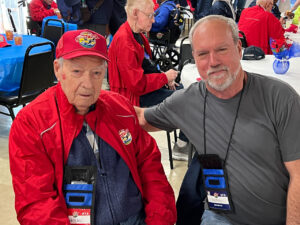
After his father headed west in search of work during the Great Depression, Bob and his sister were raised primarily by their “strict” Catholic grandparents. You’ll hear him recall being with his grandparents on December 7, 1941 when word came of Imperial Japan’s attack on Pearl Harbor.
“We were sitting in the living room and we had this big round radio that everybody had at that time,” you’ll hear McAvoy remember. “We were listening to the news when it all just came on, bam!”
Eleven days later, on December 18, 1941, with the blessing of his grandfather, who had served in the Spanish-American War, 16-year-old Bob convinced the Navy he was actually 17 and enlisted. After two weeks of expedited training in Newport, RI, he was sent to Boston to join the inaugural crew of the light cruiser USS San Diego (CL-53), which was commissioned on January 10, 1942.
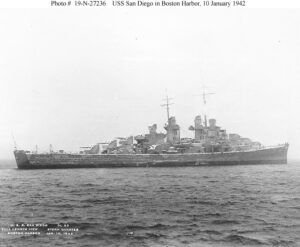
After a shakedown cruise on the east coast, the cruiser traveled through the Panama Canal and up to its namesake city of San Diego before heading out to sea. A stop in Hawaii brought McAvoy face to face with the aftermath at Pearl Harbor.
“Oil all over the harbor,” you’ll hear him explain. “Oh, it was terrible looking stuff, and smelled.”
Bob was a gunner’s mate assigned as a “trainer,” in charge of his gun’s horizontal alignment. The San Diego was assigned to a task force featuring the aircraft carrier USS Hornet (CV-8). You’ll hear him remember a very close call with a torpedo near Guadalcanal, and the tragic scene he witnessed when the Hornet was sunk in the Battle of the Santa Cruz Islands in October, 1942. Less than three weeks later, one of the San Diego’s sister ships, the USS Juneau, was sunk in the Naval Battle of Guadalcanal, causing the Navy’s to alter the rest of the cruisers in that class, including McAvoy’s, to be geared more toward anti-aircraft functionality.
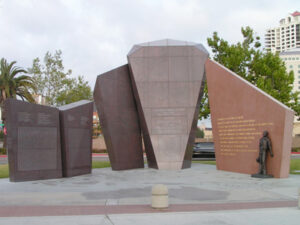
McAvoy was offered the chance to return to the states for hydraulic school, and returned to southern California, where his father was now living. That new assignment led to his meeting his first wife. They married before he shipped out on the newly minted attack transport USS Napa (APA-157), as a “plank owner” in the ship’s original crew, as he was on the USS San Diego. While aboard the Napa, he received a letter informing that his first child, a daughter, had been born. That ship delivered Marines to Iwo Jima, where Bob remembers feeling “mesmerized” as he watched the invasion forces land from his 40mm mount. In the early morning hours of February 21, 1945, Bob was awakened by something slamming through the ship’s hull not far from where he was sleeping.
“There are three bunks, I’m in the middle, and I wake up, and I’m standing on the deck next to my bunk,” he explains of the violent collision that interrupted his slumber. “I turned around to the port side, and there’s a hunk of iron sticking through.”
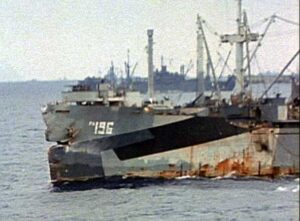
What Bob initially thought was an unexploded torpedo turned out to be part of the bow of the USS Logan, which had failed to turn when the rest of the ships in the convoy did, and inflicted significant damage to the Napa. The gaping hole in the hull was less than 30 feet from where Bob had been sleeping. Watch the video below for more of Bob’s memories from that incident:
When the ship returned to the Pacific Northwest for repairs, Bob decided to take a weekend pass to try to make it down to California to meet his daughter for the first time. He made it there hitchhiking, but couldn’t make it back to the ship in time. After unsuccessfully pleading his case in a “captain’s mass,” he spent a month making pallets at Treasure Island before being given a choice. He could accept a dishonorable discharge and leave the Navy, or commit to another year of service in order to regain honorable status before separation. He chose the latter, and was soon assigned to the supply ship USS Oberon, drawing the assignment of running the captain’s boat.
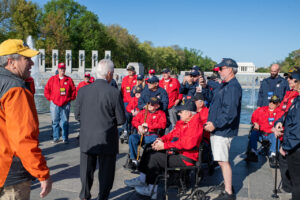
In April, 2023, Bob and his son Greg traveled to Washington, D.C. with Central Valley Honor Flight. One of just two World War II veterans on that particular flight, McAvoy was afforded the privilege of laying a wreath at Arlington National Cemetery’s Tomb of the Unknown Soldier.

“It’s the only time I have ever had anybody’s attention because of my age or what we went through during the war,” you’ll hear Bob relate. “It was so fantastic that it makes me feel good. It put some juice into me I think.”
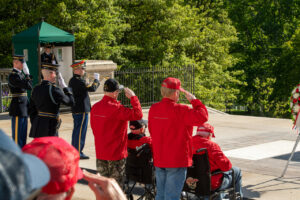
McAvoy says he has wondered at times how different his life would have been if he had declined the offer to return to the United States for training, and instead remained aboard the USS San Diego for the rest of the war. Ultimately, the devout Catholic says he knows God was directing his steps, and is eternally grateful for his family.
“Being a father is the best thing in my life,” you’ll hear him say on Hometown Heroes over Father’s Day weekend. “The way my family live, I just love them so much.”
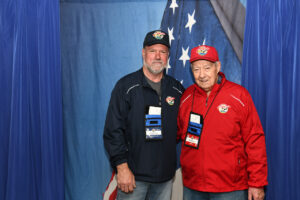
You’ll hear briefly from Greg McAvoy, Bob’s youngest son who served as his “guardian” on the Honor Flight, about the highlights of that experience from his perspective, and one impression he says he’ll carry with him for the rest of his life. Greg says his father’s example of prioritizing what matters most has been impactful for him.
“I respect his determination and his faith,” Greg McAvoy says of his dad. “He’s a good role model.”
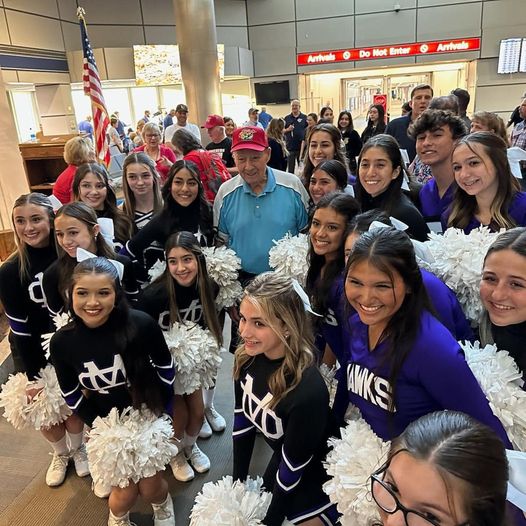



Leave a Reply